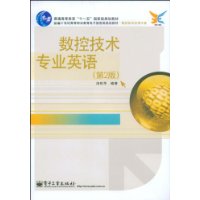数控技术专业英语(第2版)
标 签:工科 英语 高职高专教材 教材与辅导 大学 教材教辅与参考书 教材 大学英语 各工种英语 职业/行业英语 英语与其他外语
本书是一本英文版的数控技术入门教材,主要介绍数控基础、数控机床、数控操作与编程、金属切削加工与刀具、CAD/CAM应用、数控机床维护、自动化工厂、数控产品营销等方面的数控技术知识。本书取材基本上源于英美文献原著、美国数控机床制造厂商文件以及网上提供的最新技术信息。文章内容新颖,文笔流畅,图文并茂,采用简单形象的比喻来说明数控机床的工作原理和功能,具有一定的趣味性。为了训练学习者用英语获得专业信息的能力,各单元都配有大量的习题。同时,为了帮助读者顺畅地阅读英文资料,本书还介绍科技英语翻译的一般技巧。
本书可作为高等职业院校数控技术应用类专业、机电一体化类专业的教材,也可作为机械制造业及自动化领域有关技术人员或销售人员的参考书。
Unit 1 What Computer-Control Programmers And Operators Do
Part A Text(数控就业)
Part B Practice
Part C Grammar And Translation(科技英语的特点)
Unit 2 What Is Cnc
Part A Text(数控概念)
Part B Practice
Part C Grammar And Translation(被动语态的译法)
Unit 3 Fundamentals Of Cnc
Part A Text(数控基础)
Part B Practice
Part C Grammar And Translation(定语的译法)
Part D Supplementary Reading (Programming With Codes)
Unit 4 Know Your Machine
Part A Text(数控机床)
Part B Practice
Part C Grammar And Translation(As的用法)
Unit 5 Understand The Motion Types
Part A Text(运动类型)
Part B Practice
Part C Grammar And Translation(词义的正确选择)
Part D Supplementary Reading (Example Program Showing Three Types Of Motion)
Unit 6 Master The Forms Of Compensation
Part A Text(补偿形式)
Part B Practice
Part C Grammar And Translation(省译)
Part D Supplementary Reading(How To Program Cutter Radius Compensation)
Unit 7 Format Your Programs
Part A Text(程序结构)
Part B Practice
Part C Grammar And Translation(增译)
Part D Supplementary Reading (Program Structure)
Unit 8 Integrate Cad/Cam And Cnc
Part A Text(Cad/Cam和cnc集成)
Part B Practice
Part C Grammar And Translation(连词的用法)
Unit 9 High Speed Machining
Part A Text(高速加工)
Part B Practice
Part C Grammar And Translation(转译)
Part D Supplementary Reading (Characteristics Of High Speed Cutting)
Unit 10 Learn The Haas Control Panel
Part A Text(机床控制面板的操作)
Part B Practice
Part C Grammar And Translation(用户说明书的阅读)
Unit 11 Maintenance And Troubleshooting
Part A Text(机床维护和故障诊断)
Part B Practice
Part C Grammar And Translation(长句的译法)
Part D Supplementary Reading (Vibration)
Unit 12 Elements Of The Computer-Controlled Factory
Part A Text(自动化工厂的要素)
Part B Practice
Part C Grammar And Translation(科技英语翻译小技巧)
Unit 13 At Cimt
Part A Text(机床展览会)
Part B Practice
Part C Writing(如何写英文求职书)
Part D Supplementary Reading (At A Dinner Party)
Assessment 1(测试1)
Assessment 2(测试2)
Assessment 3(测试3)
Assessment 4(测试4)
Assessment 5(测试5)
Appendix A Suggested Translations(参考译文)
Appendix B List Of G Code And M Code(G代码和m代码表)
Appendix C Technical Vocabulary(专业词汇表)
Appendix D Abbreviations(缩略语)
References(参考文献)
For machines that have the ability to perform operations with several tools, there are fourkinds of program format: program start-up format, tool ending format, tool start-up format, andprogram ending format. The programmer will begin every program with program start-up format.At the completion of program start-up format, the tool will be ready to begin cutting. At this point,the programmer will program the cutting operations with the first tool. When finished cutting, theprogrammer will follow the format to end the tool (tool ending format). Then tool start-up format tobegin the second tool. The programmer will then toggle among cutting information, tool endingformat and tool start-up format until the finished cutting with the last tool. At this point, theprogrammer will follow the format to end the program.
For an example of'the four kinds of program format, refer to the program given during ourdiscussion of tool length compensation in Unit 6. This program uses two tools and follows the strictformat we are now discussing. Let's determine what commands are related to each kind of format.
The first four commands (beginning with the program number) make up the program start-upformat. At the completion of line N015, the tool is ready to begin machining. Lines N020 and N025make up the cutting commands for the first tool. (In line N020, the feedrate should be consideredpart of program start-up format.) Lines N030 and N035 form the tool ending format. Lines N040through N055 are tool startup format. (In line N060, the feedrate should be considered part of toolstartup format.) Lines N060 and N065 are the cutting commands for the second tool. And linesN070 and N075 are program ending format.
By breaking up the program in this manner, you should be able to see just how much of theprogram is nothing more than program format that can be copied from one program to another6. Ofcourse, certain word values like spindle speeds, feedrates, axis positions, and tool station and offsetnumbers will change based on the program you are currently writing. But the basic structure can becopied, keeping you from leaving out important information. Note that there are only fourcommands that do any cutting in this program. The bulk of the program is just format.
How you come up with program format information for your machine
The best way is to take an example program that is currently running successfully and break itup in the manner shown above. When doing this, analyze just what each tool is doing to determinethe various types of format7. Ensure that each tool contains all information needed to runindependently.
装 帧:平装
页 数:225
印 次:1
版 次:2版
开 本:16开
纸 张:胶版纸
正文语种:英语/中文
